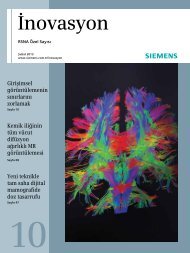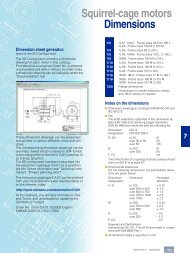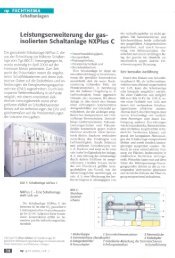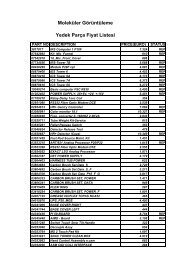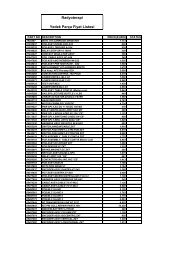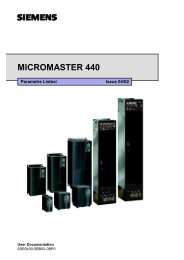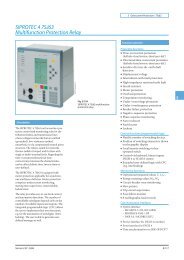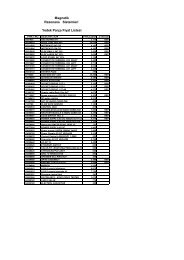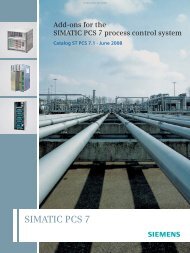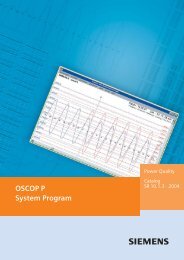Building automation â impact on energy efficiency - Siemens ...
Building automation â impact on energy efficiency - Siemens ...
Building automation â impact on energy efficiency - Siemens ...
You also want an ePaper? Increase the reach of your titles
YUMPU automatically turns print PDFs into web optimized ePapers that Google loves.
No. EMS requirements according EN 16001 BACS for EMS in building<br />
E 1<br />
E 1.1<br />
E 2<br />
E 3<br />
E 3.1<br />
3.1 General requirements<br />
The organizati<strong>on</strong> shall:<br />
a) establish, document, implement and maintain an <strong>energy</strong><br />
management system in accordance with the requirements<br />
of this standard;<br />
b) define and document the scope and the boundaries<br />
of its <strong>energy</strong> management system;<br />
c) determine and document how it will meet the requirements<br />
of this standard in order to achieve c<strong>on</strong>tinual<br />
improvement of its <strong>energy</strong> <strong>efficiency</strong>.<br />
3.2 Energy policy<br />
Top management shall establish, implement and maintain<br />
an <strong>energy</strong> policy for the organizati<strong>on</strong>. This <strong>energy</strong><br />
policy shall state the organizati<strong>on</strong>'s commitment for<br />
achieving improved <strong>energy</strong> performance. Top management<br />
shall ensure that the <strong>energy</strong> policy:<br />
a) defines the scope and boundaries of the <strong>energy</strong><br />
management system;<br />
b) is appropriate to the nature and scale of, and <str<strong>on</strong>g>impact</str<strong>on</strong>g><br />
<strong>on</strong>, the organizati<strong>on</strong>'s <strong>energy</strong> use;<br />
c) includes a commitment to c<strong>on</strong>tinual improvement in<br />
<strong>energy</strong> <strong>efficiency</strong>;<br />
d) includes a commitment to ensure the availability of informati<strong>on</strong><br />
and of all necessary resources to achieve objectives<br />
and targets;<br />
e) provides the framework for setting and reviewing <strong>energy</strong><br />
objectives and targets;<br />
f) includes a commitment to comply with all applicable<br />
requirements relating to its <strong>energy</strong> aspects, whether legally<br />
required or agreed to by the organizati<strong>on</strong>;<br />
g) is documented, implemented, maintained and communicated<br />
to all pers<strong>on</strong>s working for and <strong>on</strong> behalf of<br />
the organizati<strong>on</strong>;<br />
h) is regularly reviewed and updated;<br />
i) is available to the public.<br />
3.3 Planning<br />
3.3.1 Identificati<strong>on</strong> and review of <strong>energy</strong> aspects<br />
The organizati<strong>on</strong> shall c<strong>on</strong>duct an initial review of its<br />
<strong>energy</strong> aspects. The review of <strong>energy</strong> aspects shall be<br />
updated at predefined intervals. These reviews shall<br />
prioritize significant <strong>energy</strong> aspects for further analysis.<br />
These reviews of <strong>energy</strong> aspects shall include the following:<br />
a) past and present <strong>energy</strong> c<strong>on</strong>sumpti<strong>on</strong> and <strong>energy</strong><br />
factors based <strong>on</strong> measurement and other data;<br />
Top management should generally note and c<strong>on</strong>sider<br />
the following when implementing an <strong>energy</strong><br />
management system (EMS):<br />
– BACS <str<strong>on</strong>g>impact</str<strong>on</strong>g> <strong>on</strong> <strong>energy</strong> <strong>efficiency</strong> of buildings<br />
per to EN 15232.<br />
– Applicati<strong>on</strong> of BACS as the appropriate tool to<br />
simplify, maintain and improve the <strong>energy</strong><br />
management process to achieve improved <strong>energy</strong><br />
performance of and reduce <strong>energy</strong> c<strong>on</strong>sumpti<strong>on</strong><br />
in buildings.<br />
As part of an <strong>energy</strong> policy, top management tasks<br />
the organizati<strong>on</strong> as a whole to maintain and improve<br />
<strong>energy</strong> performance of buildings (existing<br />
buildings, modernized, new c<strong>on</strong>structi<strong>on</strong>):<br />
Mandatory and specific BACS <strong>energy</strong> <strong>efficiency</strong><br />
class (according to EN15232) for implementati<strong>on</strong><br />
and compliance.<br />
Deploy <strong>on</strong>ly <strong>energy</strong>-efficient, certified products as<br />
BACS comp<strong>on</strong>ents.<br />
Use BACS as a tool for EMS and as the documentati<strong>on</strong><br />
and informati<strong>on</strong> system in support of the organizati<strong>on</strong>.<br />
The organizati<strong>on</strong> should c<strong>on</strong>sider the BACS opti<strong>on</strong>s<br />
that identify and review <strong>energy</strong> aspects for EMS in<br />
buildings, such as:<br />
Specify and use BACS logs (data) <strong>on</strong> <strong>energy</strong> c<strong>on</strong>sumpti<strong>on</strong><br />
including all parameters that <str<strong>on</strong>g>impact</str<strong>on</strong>g>ing<br />
<strong>energy</strong> and review <strong>energy</strong>-relevant aspects in buildings.<br />
Specify BACS data to be recorded, stored and delivered,<br />
e.g.:<br />
93



